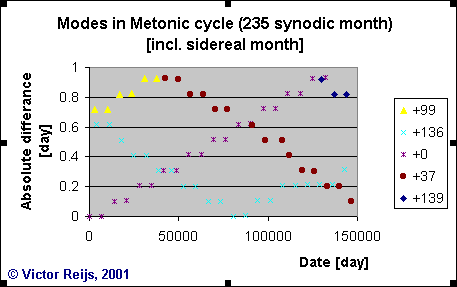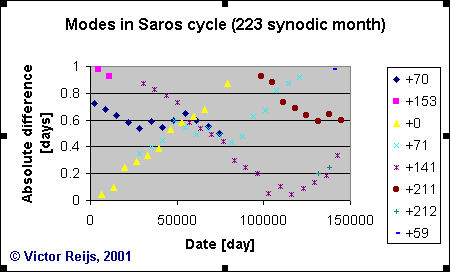 Home
Home Up
Up Search
Search Mail
Mail
NEW
Modes due to lunar and solar periods
Some cycles with lunar and solar periods are known
in astronomy and history:
For these cycles it has been calculated when the lunar/solar month/year
period fit best on a certain Date (unsing the FDM). Comparable studies can be
done
for other cycles (if you want a cycle to be covered, let me
know).
I have kept the durations of all periods te same, although they slowly
change over time: the durations of period , which I used in the below
evaluation, changes only some 0.000007%
over the 410 years.
Metonic cycle
The following method has been used for the Metonic cycle:
- In steps of 0.1 day and from an arbitrary Date (Date=0),
the quotient of Date and every month or year period has been
calculated
and thus one knows how much a certain month/year period differs from a
precise fit (a whole number).
- On Dates with (almost-)fits, the difference with
multiples of the
tropical
year
is determined. The tropical year is taken because on these Dates,
the phase of the moon (synodic) will change slower than the sun's
position
(tropical).
- If the absolute value of the tropical difference is smaller than
1 day,
it has been plotted in a graph.
The following graph is obtained for the Metonic cycle; every symbol is
a point where the difference (with regard to a precise fit) was smaller
than 1 day:
 What can be seen in the above graph:
What can be seen in the above graph:
- Equal colored symbols in a graph shows a series of Dates
that
repeat
themselves with the cycle-studied. I call a colored serie: a mode
(somewhat analogue to modes in standing waves).
- The only difference between the modes (colored series) is that
they
have
a delayed Starting Date. So for instance the purple mode in the
Metonic graph has it's first almost-fit not on Date=0 but on
delayed Starting
Date=136 synodic months.
- The graph seems to repeat itself around Date=129000 days
(look
at
the repeating form of the graph and the repeating relative Starting
Dates). I assume there is a good reason for this (if you know of
similar periods in literate, let me
know). It looks to be 12*synodic month*tropical year.
- The modes with the smallest solar difference are with Starting
Date of 0 and then taken over by mode with delayed Starting
Date of
136 synodic months
Metonic cycle incl. sidereal months
The following method has been used for the Metonic cycle incl. sidereal
months:
- In steps of 0.1 day and from an arbitrary Date (Date=0),
the quotient of Date and every month or year period has been
calculated
and thus one knows how much a certain month/year period differs from a
precise fit (a whole number).
- On Dates with (almost-)fits, the difference with
multiples of the
sidereal
month
is determined. The sidereal month is taken because on these Dates,
the phase of the moon (synodic) and sun's position (tropical) will
change
slower than the place of the moon with regard to the stars (sidereal).
- If the absolute value of the sidereal difference is smaller than
1 day,
it has been plotted in a graph.
The following graph is obtained for the Metonic cycle incl. sidereal
months;
every symbol is a point where the difference (with regard to a precise
fit) was smaller than 1 day:
 What can be seen in the above graph:
What can be seen in the above graph:
- Equal colored symbols in a graph shows a series of Dates
that
repeat
themselves with the cycle-studied. I call a colored serie: a mode
(somewhat analogue to modes in standing waves).
- The only difference between the modes (colored series) is that
they
have
a delayed Starting Date. So for instance the light blue mode in
the Metonic graph has it's first almost-fit not on Date=0 but
on
delayed Starting Date=136 synodic months.
- The graph seems to repeat itself around Date=80500 days
(look
at
the repeating form of the graph and the repeating relative Starting
Dates). I assume there is a good reason for this (iif you know of
similar periods in literate, let me
know).
- The modes with the smallest lunar difference are with Starting
Date of 0 and then taken over by mode with delayed Starting
Date of
136 synodic months
Saros cycle
The following method has been used for the Saros cycle:
- In steps of 0.1 day and from an arbitrary Date (Date=0),
the quotient of Date and every month period has been calculated
and thus one knows how much a certain month period differs from a
precise
fit (a whole number).
- On Dates with (almost-)fits, the difference with
multiples of the
draconic
month
is determined. The draconic month is taken because on these Dates,
the phase of the moon (synodic) and the closeness of the moon to the
earth
(anomalistic) will change slower than the lunar position near the
ecliptic
(draconic).
- If the absolute value of the draconic difference is smaller than
1 day,
it has been plotted in a graph.
The following graph is obtained for the Saros cycle; every symbol is a
point where the difference (with regard to a precise fit) was smaller
than
1 day:

What can be seen in the above graph:
- Equal colored symbols in a graph shows a series of Dates
that
repeat
themselves with the cycle-studied. I call a colored serie: a mode
(somewhat analogue to modes in standing waves).
- The only difference between the modes (colored series) is that
they
have
a delayed Starting Date. So for instance the dark purple mode
in
the Saros graph has it's first almost-fit not on Date=0 but on
delayed Starting
Date=141 synodic months.
- The graph seems to repeat itself around Date=110000 days
(look
at
the repeating form of the graph and the repeating relative Starting
Dates). I assume there is a good reason for this (if you know of
similar periods in literate, let me
know). It looks to be 5*draconic month*synodic month*anomalistic
month.
- The modes with the smallest lunar difference are with Starting
Date of 0 and then taken over by mode with delayed Starting
Date of
141 synodic months
General remarks
The above graphs provides some insight what and how people in former
times
could have measured/experienced similar occurrences, if they would have
historic
tables/tallies
of information. In my opinion, they should at least have this
information
for several occurrences, say 50-100 years, otherwise accuracy could be
too low.
Disclaimer and Copyright
 Home
Home Up
Up Search
Search Mail
Mail
Last major content related changes: May 5, 2001


